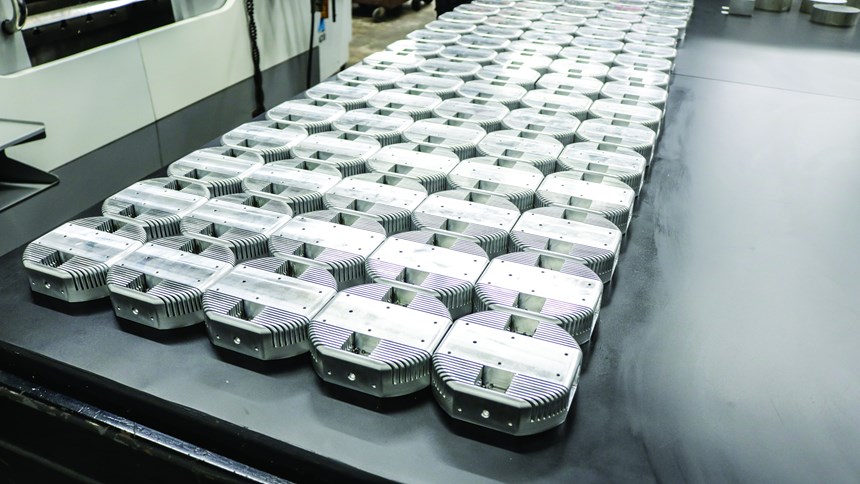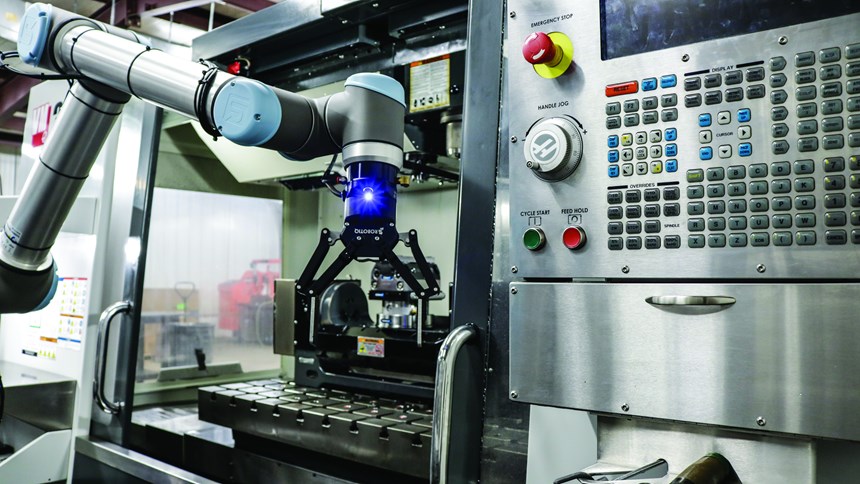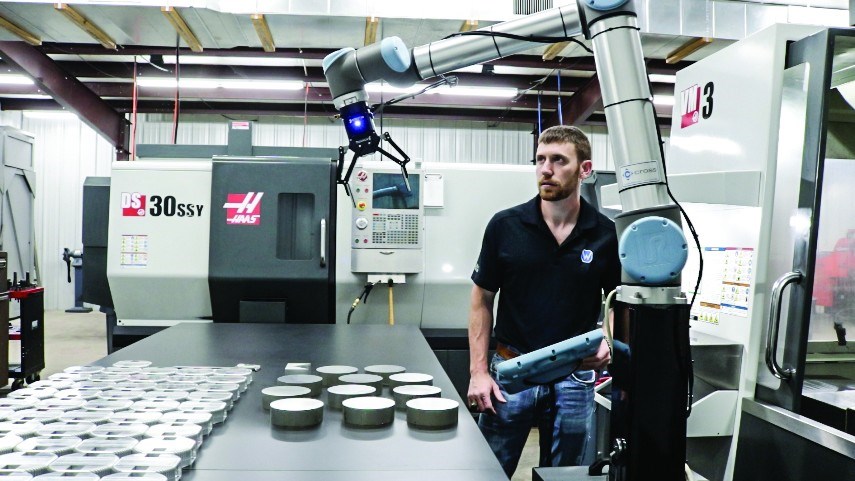Robot Wrist Camera Helps Double Production
Automation can be one way to deal with time constraints without losing quality, which is what Walt Machine Inc. did by implementing the Plug and Play Wrist Camera from Robotiq on the company’s existing robot.
When faced with a challenging order, it’s natural for a shop to strive for the simplest way to handle the production process while being as efficient as possible. Implementing automation can be one way to deal with time constraints without losing quality.
Management at a shop specializing in high precision optical work for scientific cameras quickly discovered the benefits of automation after it purchased a robot a few years ago. The company, Walt Machine Inc., was faced with an order of 6,000 camera housings to be shipped in two months, using only one CNC machine. However, a vision system or a conveyor was still needed to pick up the raw parts from the table.
“Everyone told me that this was a difficult process and that we needed to have a person in our shop to do it,” President Tommy Caughey says.
However, after implementing the Plug and Play Wrist Camera from Robotiq on the company’s existing robot, Mr. Caughey realized that “everyone” was wrong. “I didn’t need a vision expert anymore—I could do it myself,” he says. “I bought the camera, and it’s super simple. It takes about 10 minutes and a part is taught.”
Turning it On with Lights-Out
The Lumberton, Mississippi-based shop realized that its robot, complete with the wrist camera, offers lights-out manufacturing capabilities with continued production after the workday is over, doubling the shop’s output. Having the ability to run its machines 15 to 20 hours a day, non-stop, and eliminating the need to hire an operator is a great benefit for the company. Without the robot, it would take one CNC machine 30 to 45 minutes to machine one side of the camera housings and several weeks of work to produce this order.
No Robot Expertise, No Problem
Robotic automation can be intimidating for someone who never touched a robot before. However, Mr. Caughey didn’t let apprehension stand in his way of learning how to use the robot. “When it first arrived, I did a little reading and realized that it was pretty simple,” he says. “There is a lot of help for programming on the Universal Robots and Robotiq websites.”
Mr. Caughey was especially impressed with the wrist camera teaching methods. A part can be taken out and set on the surface, and four snapshots can be taken of it in four different orientations. With something simple such as a rectangular or a circular blank, the dimensions can be set, and the robot is then programmed.
Then, with 15 to 20 of the same unmachined parts on the table within the camera’s field of view, the robot can rotate and look over the table, and take one snapshot to see all the parts. For more accurate picking, it gets closer and takes another snapshot of the part it is about to pick. Then, the robot places the part into the vice in the CNC machine and sends a signal to the Haas CNC machine to press the start button.
“It is so easy,” Mr. Caughey adds. “We don’t even have to teach waypoints because the wrist camera only needs to look on this table for parts. We don’t need a conveyor or any special fixturing. If you change parts, you need to tell the robot that you are looking for a different part and change the 2-Finger Gripper’s closing setup. There isn’t a lot of change-over, so that’s why I like the camera-gripper combo.”
Improving Jobs for Existing Workers
Walt Machine’s robot has been beneficial not only for the company as a whole and its customers, but also for its employees, such as long-time machinist Matthew Niemeyer. The robot first challenged him to learn the new skillset of programming it. Then, although he no longer needs to load the machine since that’s the robot’s job, he is still responsible for the fine-tuning of the machine, including the programming.
“But the remedial tasks of loading and unloading the machine is taken care of for you, so you don’t get worn out,” he says.
The robot’s arrival created an opportunity for Mr. Niemeyer to become a sales representative for the team. When everything is running fine in the factory, he is able to focus on this new role.
Mr. Niemeyer is an example of how robots don’t take the human element out of a process, but instead, change where the work is needed. Instead of employees moving parts in and out of the machine, they can do more quality-related work such as checking parts, cleaning them, packaging them and even bring in more sales.
Mr. Caughy believes that in 10 years, every small shop like his will have at least one robot. With a robot that doubles production capacity, Walt Machine has increased its business opportunities and has ensured that orders are delivered on time. Now that Walt Machine has completed its first integration project, Mr. Caughey sees these new business opportunities on the horizon as a way to scale robotics capabilities in the shop.
For more information from Walt Machine Inc., call 601-796-8269 or visit waltmachineinc.com.
For more information from Robotiq, call 888-762-6847 or visit robotiq.com.
Related Content
Automation Idea for Halloween?
Maybe not. But, the candy-throwing robots at MetalQuest’s Nebraska facility do enable the contract machine shop to stand out at career fairs and similar events.
Read MoreIncreased Competition Calls for Smarter Solutions
Engineered for efficiency, SW Machines offers customers a full suite of horizontal machining centers and the automation needed for high-volume, high-precision manufacturing.
Read MoreJob Shop Discovers and Fills a Fishing Need
The promise of a product line for improved mounting of electronic fish finders led this Missouri job shop to an automated turning process.
Read MoreRobotic Machine-Tending Ideas for Production Shops
Here are five examples of how machine shops have benefited in various ways by adding robots to tend machine tools.
Read MoreRead Next
Reducing Production Times with Robotic Automation
A complete overhaul of its processes using lean principles helped this shop improve production by almost 90 percent.
Read MoreFinding the Right Tools for a Turning Shop
Xcelicut is a startup shop that has grown thanks to the right machines, cutting tools, grants and other resources.
Read MoreHow To (Better) Make a Micrometer
How does an inspection equipment manufacturer organize its factory floor? Join us as we explore the continuous improvement strategies and culture shifts The L.S. Starrett Co. is implementing across the over 500,000 square feet of its Athol, Massachusetts, headquarters.
Read More

























